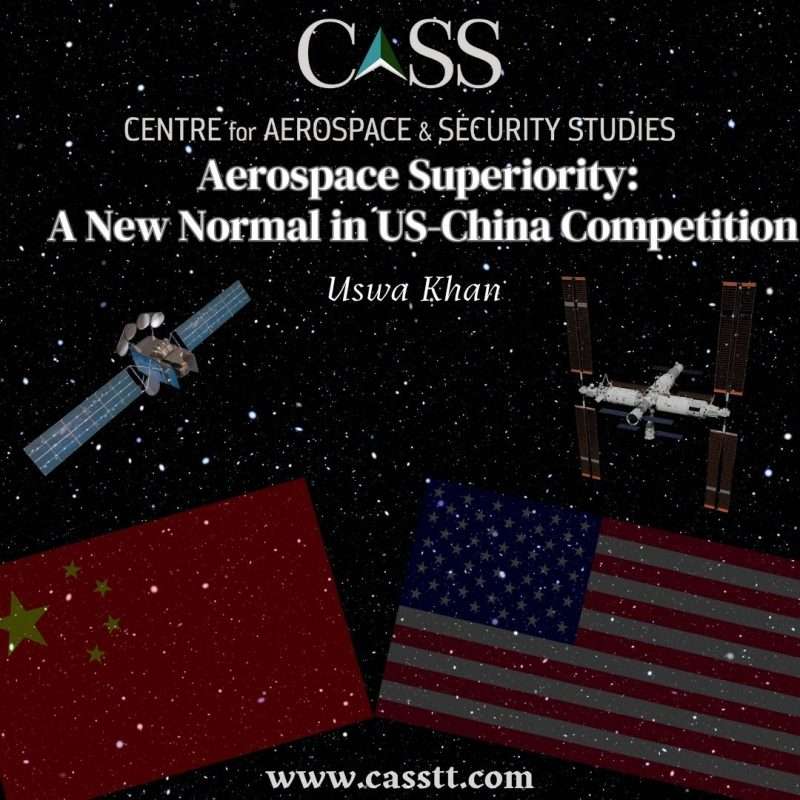In recent decades, there have been substantial developments in the aerospace industry around the globe. With considerable increase in funding, innovation in the aerospace sector has gained significant momentum, fostering more competition in the respective domain. In 2021, around USD10 billion capital was invested in space companies. Similarly, the United States (US) and China have been actively investing in the aerospace capabilities, local industries, and human resource for both military and commercial purposes.
In navigating the debate surrounding the significance of aerospace in modern times and the pursuit of aerospace superiority between the US and China, an essential precursor is a nuanced understanding of the term ‘aerospace.’ Beyond its lexical amalgamation of air and space, aerospace constitutes a strategic juxtaposition, akin to a sophisticated chess match unfolding across the mediums of air and space. According to Major Carl Baner, ‘Air assets are governed by the laws of aerodynamics and tend to be more flexible and more responsive. Space assets are governed by orbital mechanics and tend to cover wider areas of the earth and provide a more continuous presence’. Moreover, in his book ‘Aerospace Power in the Twenty-First Century – A Basic Primer’, Dr Clayton K.S. Chun, a former officer in U.S. Air Force notes that, ‘Aerospace power includes air, space, and the integration of air and space power’. Based on these definitions, three key takeaways can be drawn: first, the term ‘aerospace’ reflects a synergy among various mediums and operational assets. Second, the essence of aerospace lies in the apt utilisation of both aerodynamics and orbital mechanism; and third, if this orchestration is conducted to its full capacity, it will lead to an unequivocal superiority over adversaries.
When it comes to utilising space above Earth’s surface for military operations that align with national objectives, aerospace power is an essential component. The Gulf War (1990-1991), for instance, witnessed the use of satellites along with deployment of US air power assets. During Operation Desert Storm, US satellites provided real-time imagery to its Air Force’s combat aircrafts i.e., F-16 which enabled them to locate and eliminate Iraqi military strategic assets, both stationary and mobile. All these military campaigns in operation Desert Storm relied heavily on aerospace assets. More recently, during the Russian-Ukraine war, Elon Musk’s Starlink, an advanced satellite system, enabled Ukrainian Aerial Reconnaissance unit to accomplish surveillance and conduct intelligence collection operations against Russian forces. The intrinsic value of space systems in enhancing terrestrial activities ranging from communication to navigation and intelligence – further underscores their critical role in military operations.
Aerospace superiority transcends being merely a technological achievement; it is a strategic cornerstone that seamlessly integrates military prowess, strategic behaviour, and economic strength. This concept is particularly evident in the current era, characterised by the ongoing aerospace rivalry between the US and China. This struggle highlights how aerospace dominance is not just about technological advancements but also involves strategic and economic dimensions, shaping global power dynamics. This competition extends beyond the skies, encompassing the space domain, where both states are vying for supremacy in anti-satellite capabilities, cyber-systems, hypersonic systems, and manoeuvrable space crafts in addition to the separate international space stations. This strategic race underscores the pivotal role of aerospace superiority not only in conventional defence but also in shaping the future of technological innovation, economic growth, and global influence.
For instance, the US boasts a long-standing tradition of substantial investment in the aerospace industry, with the National Aeronautics and Space Administration (NASA) playing a pivotal role in the country’s space programme, particularly in research and development. The country also has a robust private sector with leading aerospace and defence companies like Northrop Grumman, SpaceX, Lockheed Martin. According to a report published by the Aerospace Industries Association (AIA), the Aerospace and Defence (A&D) industry contributed approximately USD 952 billion in sales revenue in 2022 and economic value of USD 418 billion.
China has risen as a formidable contender in the aerospace industry, making significant investments and advancements in companies, Research and Development (R&D), modern stealth technologies, aerial capabilities, low-altitude economy and the modernisation of its Air Force. This progress presents a direct challenge to US air superiority. The private aerospace sector in China grew from 376.4 billion yuan in 2015 to 836.2 billion yuan in 2019, registering a compound annual growth rate of 22.1%. This sector is projected to surpass 2.4 trillion yuan by 2024. With companies like China Aerospace Corporation (CASC), and others playing a greater role in space technology development, China has built a burgeoning commercial aerospace sector. The country’s ambitious space programme, which includes plans to launch crewed spacecraft to the moon by 2030 and develop nuclear-powered space shuttles by 2040, aims to make it a global space power by 2045. Along with other space research efforts, the China National Space Administration (CNSA) has also been exploring Mars, and crewed space flights.
Aerospace superiority has now become a critical factor in determining a nation’s security, defence standing, and ability to protect its interests in a deeply interconnected world. The intense rivalry between the US and China encapsulates this reality, illustrating a strategic contest that goes beyond technological rivalry to profoundly affect global security and economic stability. Moreover, the unfolding discourse makes it obvious: the future world order will likely be defined by those who command aerospace superiority, decisively shaping the balance of power on the global stage.
Uswa Khan is a Research Assistant at the Centre for Aerospace & Security Studies (CASS), Islamabad, Pakistan. She can be reached at: [email protected].
Design Credit: Mysha Dua Salman





